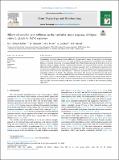Por favor, use este identificador para citar o enlazar a este item:
http://hdl.handle.net/10261/284793COMPARTIR / EXPORTAR:
 SHARE SHARE
 CORE
BASE CORE
BASE
|
|
| Visualizar otros formatos: MARC | Dublin Core | RDF | ORE | MODS | METS | DIDL | DATACITE | |

| Título: | Effects of ascorbic acid addition on the oxidative stress response of Oryza sativa L. plants to As(V) exposure |
Autor: | Álvarez Robles, María José; Clemente Carrillo, Rafael CSIC ORCID; Ferrer, M. A.; Calderón, Antonio; Bernal Calderón, M. Pilar CSIC ORCID | Palabras clave: | Priming effect Rice Hydroponics Proline Stress indicators |
Fecha de publicación: | 1-sep-2022 | Editor: | Elsevier | Citación: | Plant physiology and biochemistry 186: 232- 241 (2022) | Resumen: | Accumulation of noxious elements in the edible part of crops and its impact on food safety is of increasing concern. Rice is one of the major staple food crops worldwide, including arsenic (As)-polluted areas, in which dietary As exposure is becoming a widespread health threat. Plant chemical priming has been shown to be an effective strategy to enhance tolerance to environmental stresses, including metal(loid) exposure. The priming effect of ascorbic acid (AsA) was assessed in rice seedlings exposed to As(V) in a hydroponics experiment. AsA treatment (co-addition to the growing media concomitantly (t0) or 24 h in advance (t24)) prevented an excessive accumulation of As in the roots (that decreased ∼ 60%) and stimulated the activities of photosynthetic and antioxidant attributes (∼1.2-fold) in the aerial part of the plants. The increase in proline levels in both shoots (∼2.1-fold) and roots (∼2.4-fold) was found to be the most sensitive stress parameter, and was able to reflect the AsA-induced reduction of As toxic effects (concentrations back to Control levels, both simultaneously added or added as a pretreatment) in the aerial part of the plants. However, the phytotoxic effects related to As exposure were not fully prevented by priming with AsA, and further research is needed to find alternative priming approaches. | Versión del editor: | http://dx.doi.org/10.1016/j.plaphy.2022.07.013 | URI: | http://hdl.handle.net/10261/284793 | DOI: | 10.1016/j.plaphy.2022.07.013 | Identificadores: | doi: 10.1016/j.plaphy.2022.07.013 issn: 1873-2690 |
| Aparece en las colecciones: | (CEBAS) Artículos |
Ficheros en este ítem:
| Fichero | Descripción | Tamaño | Formato | |
|---|---|---|---|---|
| Alvarez2022PPB.pdf | 4,64 MB | Adobe PDF |  Visualizar/Abrir | |
| Alvarez2022PPBSup.docx | 20,7 kB | Microsoft Word XML | Visualizar/Abrir |
CORE Recommender
SCOPUSTM
Citations
9
checked on 22-abr-2024
WEB OF SCIENCETM
Citations
4
checked on 27-feb-2024
Page view(s)
31
checked on 24-abr-2024
Download(s)
39
checked on 24-abr-2024
Google ScholarTM
Check
Altmetric
Altmetric
Este item está licenciado bajo una Licencia Creative Commons

